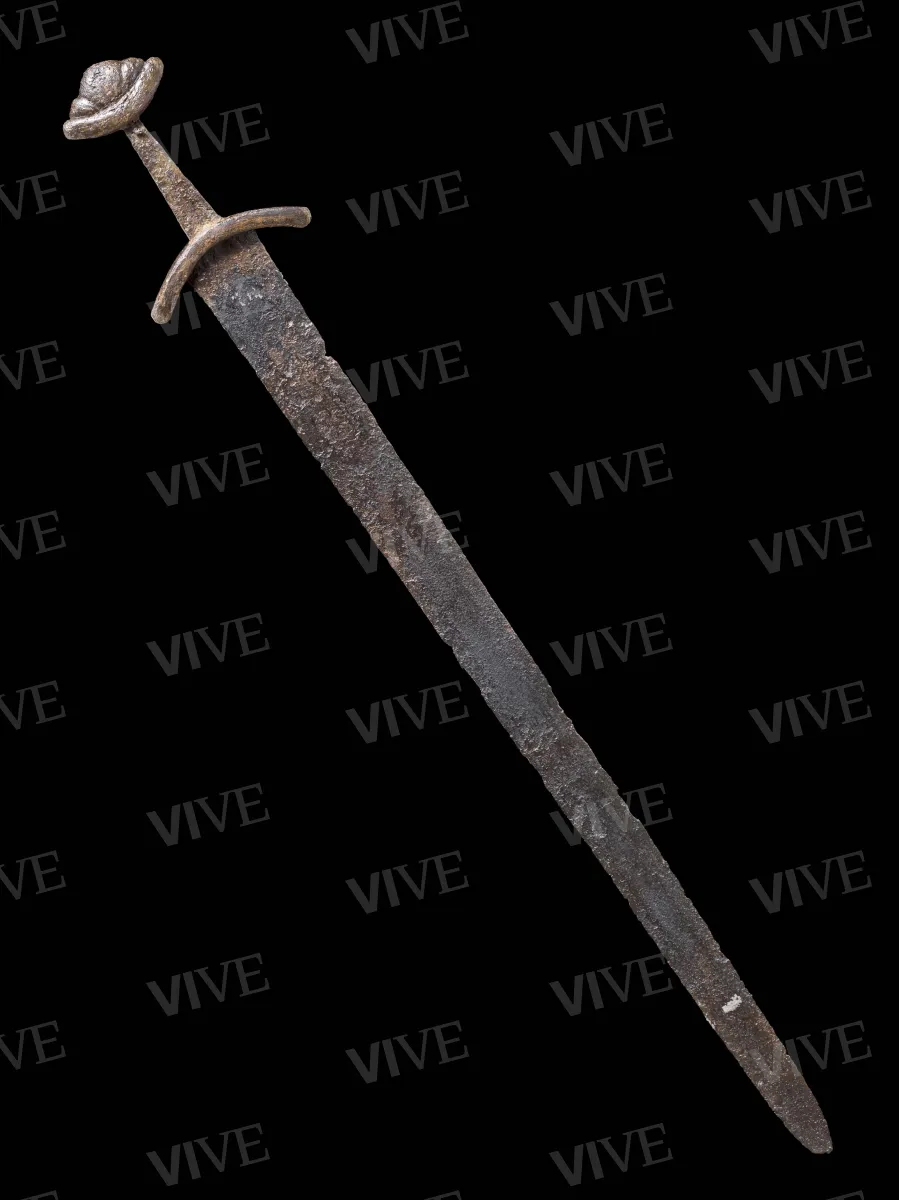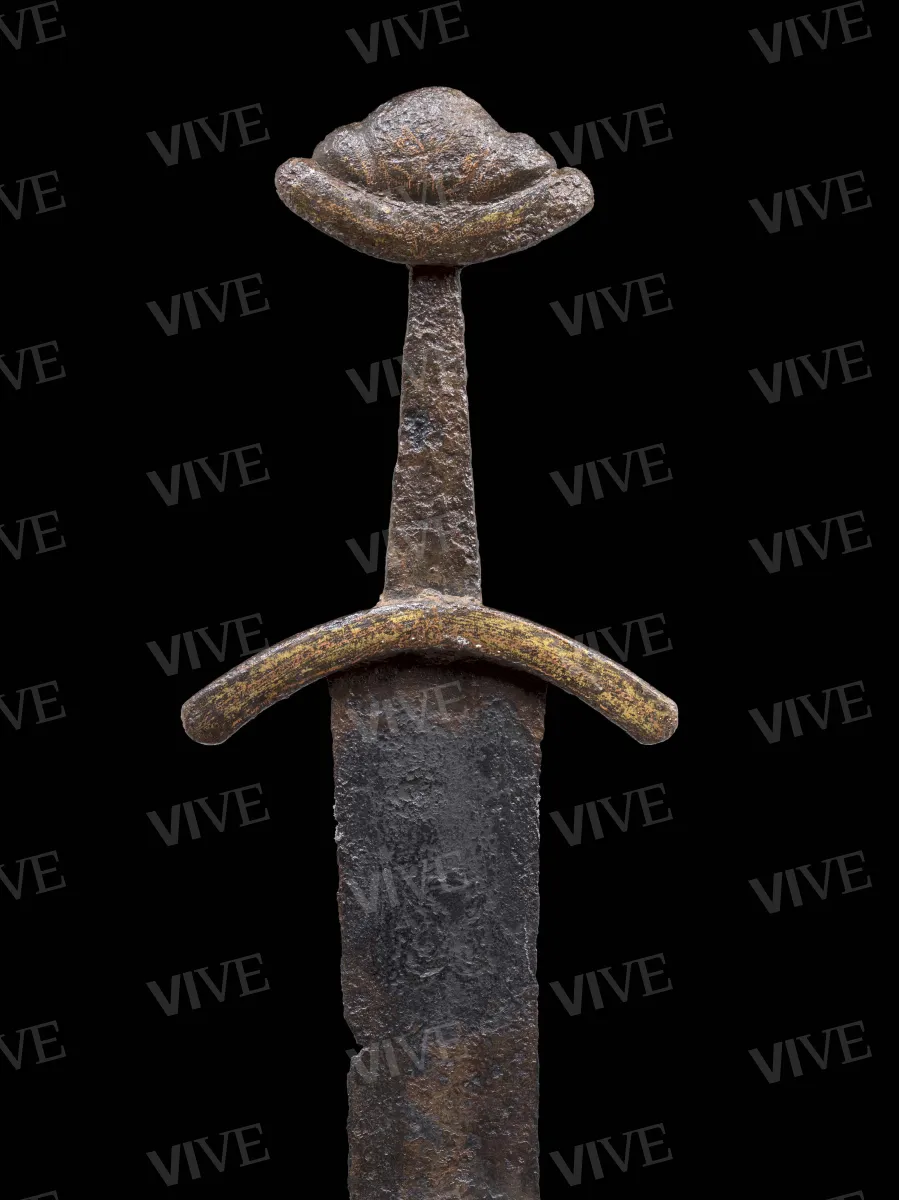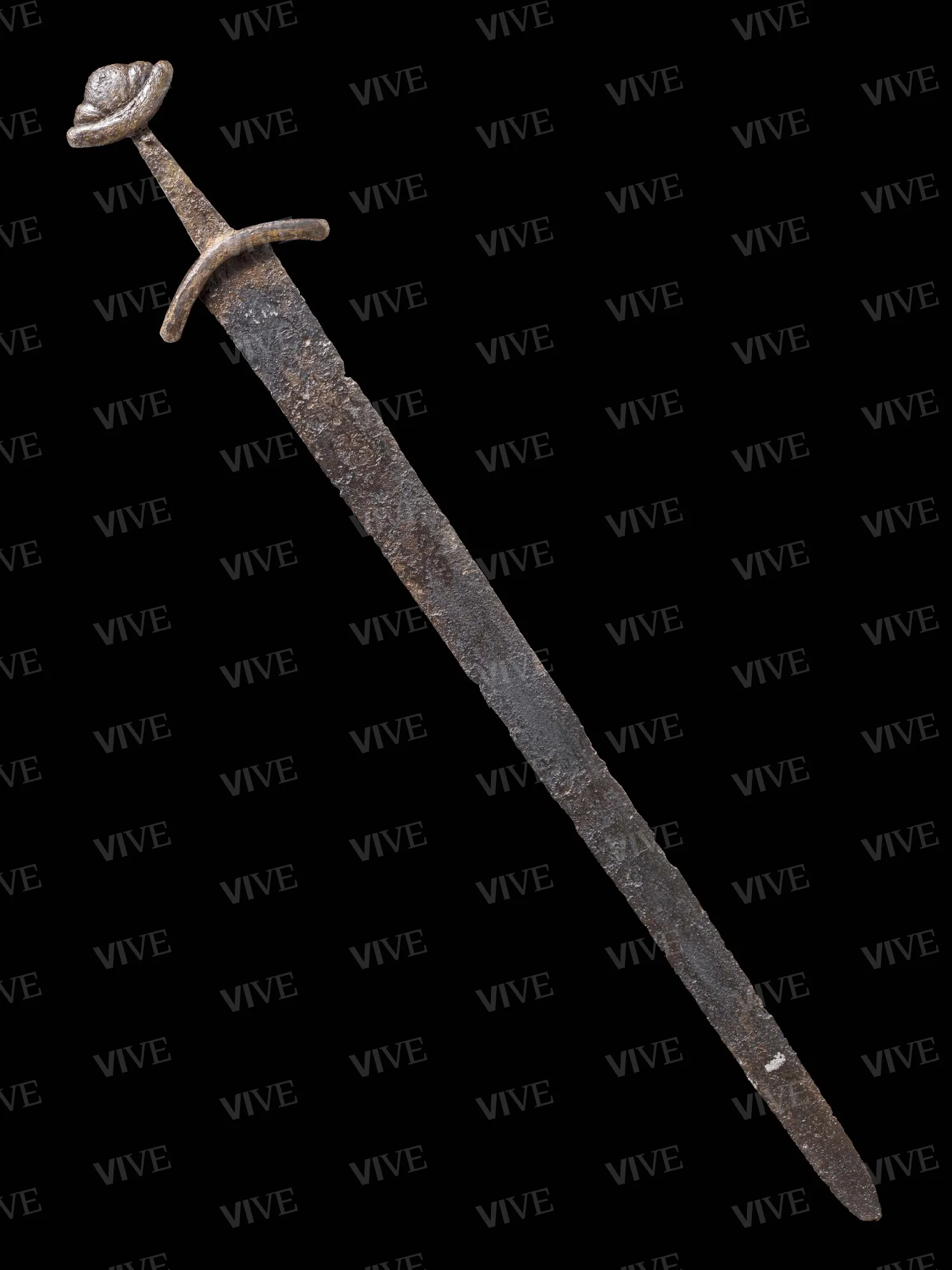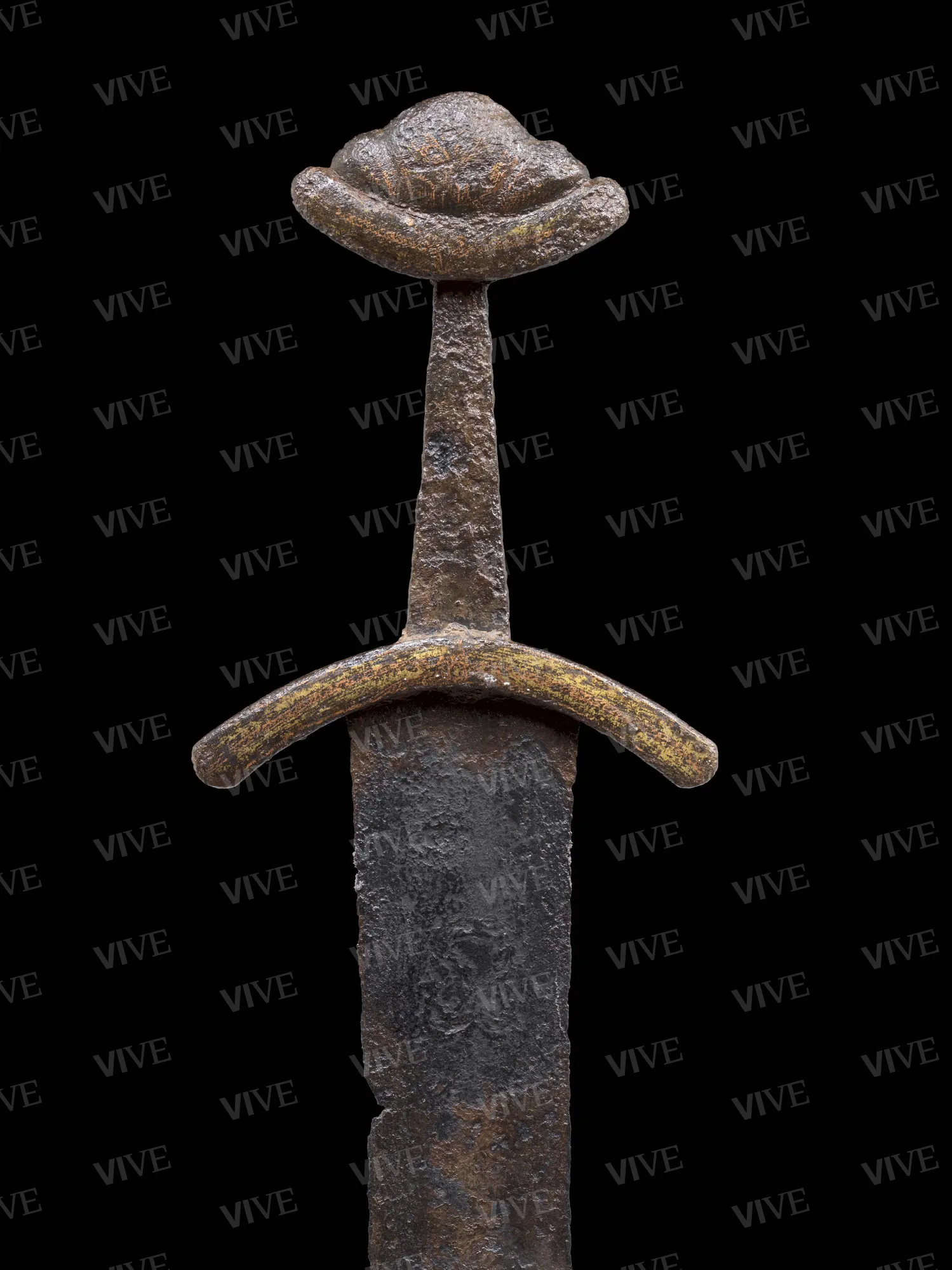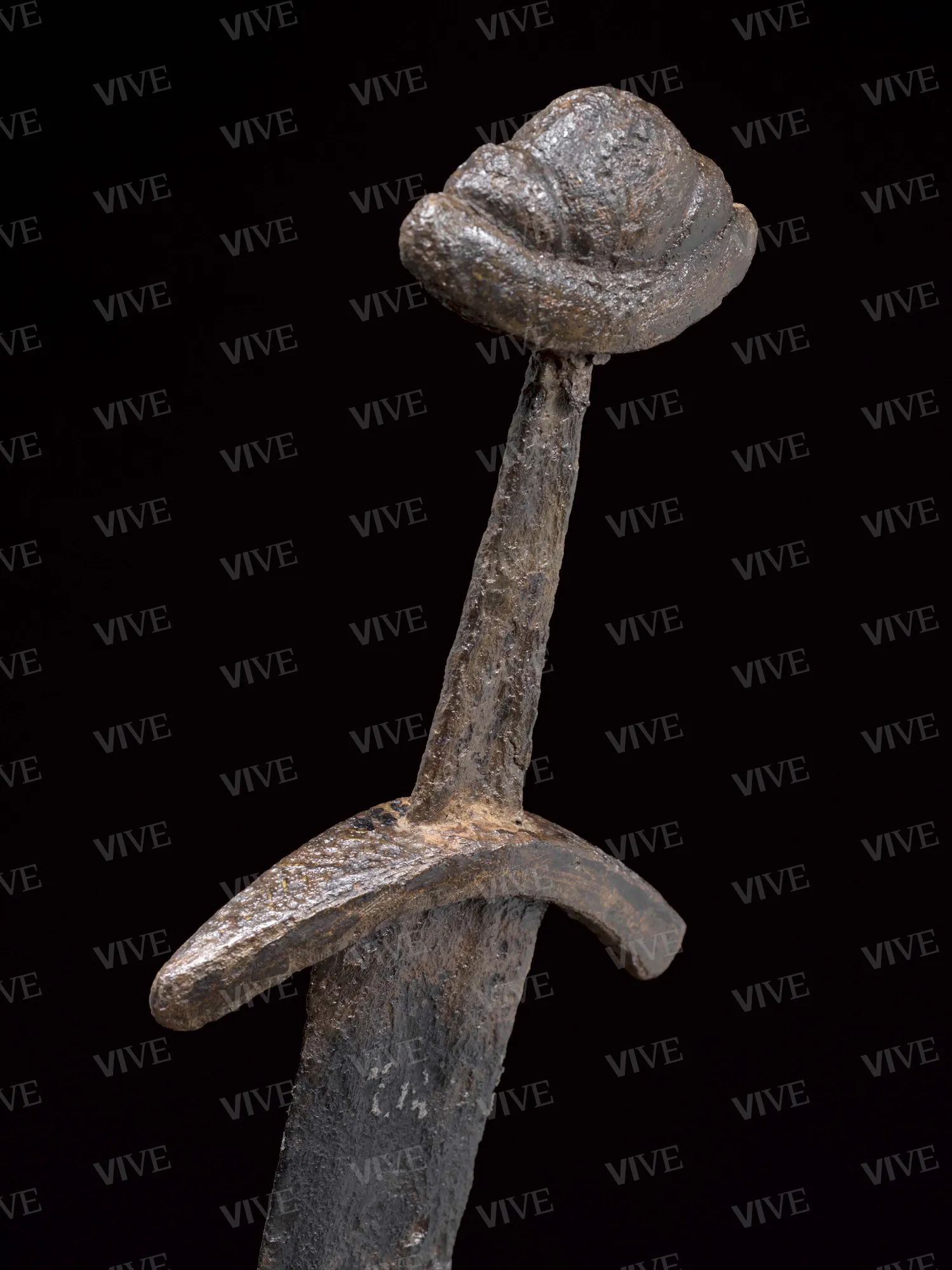Viking sword
North European production 10th–11th century
Sword from the Scandinavian area and datable to between the tenth and eleventh centuries. It has a radically fullered blade, a hilt with square-sectioned downward-curved quillons; a “boat-shaped” three-lobed pommel on a curved base (the central lobe of the pommel is larger than the others); hilt and pommel are decorated with a cross-hatched dash motif made with brass damascening.
Sword from the Scandinavian area and datable to between the tenth and eleventh centuries. It has a radically fullered blade, a hilt with square-sectioned downward-curved quillons; a “boat-shaped” three-lobed pommel on a curved base (the central lobe of the pommel is larger than the others); hilt and pommel are decorated with a cross-hatched dash motif made with brass damascening.
Details of work
Catalog entry
Nolfo di Carpegna likens the peculiar type of lobed grip, of debatable origin, to a number of northern European swords found in England, Russia, and Finland (di Carpegna 1969), including one held at London’s British Museum (Oakeshott 1954, fig. 58) and others illustrated by Bruhn Hoffmeyer (Bruhn Hoffmeyer 1964, pl. III) and Leppäaho (Leppäaho 1964, pl. 10, no. 2). The weapon was later likened by Mario Scalini to a slightly later sword found in Florence, now at the Museum of Art in Philadelphia (Terjanian, 2007, p. 102; Scalini 2018). The unusual bulge of the lobes on the pommel is probably attributable to the practice of tying leather and cloth padding to the crossbar (which originally functioned as a pommel): the bulge allowed the fighter to use his chest to push the sword so that its point could penetrate through solid armor. In this case, however, the pommel type is aesthetically similar to the type of sword in Florence described by Scalini—even though his sword has five cusps (and does not fully correspond to ours)—albeit not maintaining the same function (see Scalini 2018). Our sword was probably used to slash at shields and not armor, for which the blade would have been unsuitable. Scalini also posits that this type of hilt is responsible for more elaborate shapes at the end of the crossguard, as can be seen in the sword of Jaxa of Miechow, lord of the Obodrites in Pomerania, now in Florence at the Bargello Museum (inv. 82R, datable to post 1150), and that this type was to spread gradually throughout the Scandinavian area (Scalini 2007). Scalini also points to a specimen found in London near Westminster, which is morphologically similar to ours (Davidson 1994, fig. 68; Scalini 2007).
Chiara Paniccia
Entry published on 12 February 2025
State of conservation
Good.
Restorations and analyses
May 1994: ordinary maintenance.
Provenance
Collezione Odescalchi 1959.
Exhibition history
Rome, Palazzo Venezia, Antiche armi dal sec. IX al XVIII già Collezione Odescalchi, May–July 1969;
Aosta, Museo Archeologico Regionale, A bon droyt. Spade di uomini liberi, cavalieri e santi. Epées d’hommes libres chevaliers et saints, June 29–November 4, 2007;
Rome, Castel Sant’Angelo; Palazzo Venezia, Armi e potere nell’Europa del Rinascimento, July 26–November 11, 2018.
Sources and documents
Tomei Alessandro, Scheda OA n. 31047 della Soprintendenza per i beni artistici e storici di Roma, October 1977
References
Oakeshott Ewart, The Archaeology of Weapons: Arms and Armour from Prehistory to the Age of Chivalry, Dover 1954, fig. 58;
Bruhn Hoffmeyer Ada, Middelalderens Tveaggede Svaerd, Copenhagen 1964, tav. III;
Leppäaho Jorma, Späteisenzeitliche Waffen aus Finnland, Helsinki 1964, tav. 10, n. 2;
di Carpegna Nolfo (a cura di), Antiche armi dal sec. IX al XVIII già Collezione Odescalchi, catalogo della mostra (Roma, Palazzo Venezia, maggio-luglio 1969), Roma 1969, p. 33;
di Carpegna Nolfo, Le armi Odescalchi, Roma 1976, p. 33;
Davidson Ellis, The sword in Anglo-Saxon England: its archaeology and literature, Woodbridge [1962] 1994, fig. 68;
Scalini, Maestro spadaio dell'Europa settentrionale. 7. Spada, in Scalini Mario (a cura di), A bon droyt. Spade di uomini liberi, cavalieri e santi. Epées d'hommes libres chevaliers et saints, catalogo della mostra (Aosta, Museo Archeologico Regionale, 29 giugno-4 novembre 2007), Cinisello Balsamo 2007, p. 101;
Terjanian, in Scalini Mario (a cura di), A bon droyt. Spade di uomini liberi, cavalieri e santi. Epées d'hommes libres chevaliers et saints, catalogo della mostra (Aosta, Museo Archeologico Regionale, 29 giugno-4 novembre 2007), Cinisello Balsamo 2007, p. 102, n. 8;
Scalini, I.2 Spada "vichinga", in Scalini Mario (a cura di), Armi e potere nell'Europa del Rinascimento, catalogo della mostra (Roma, Castel Sant'Angelo; Palazzo Venezia, 26 luglio-11 novembre 2018), Cinisello Balsamo 2018, p. 47.

